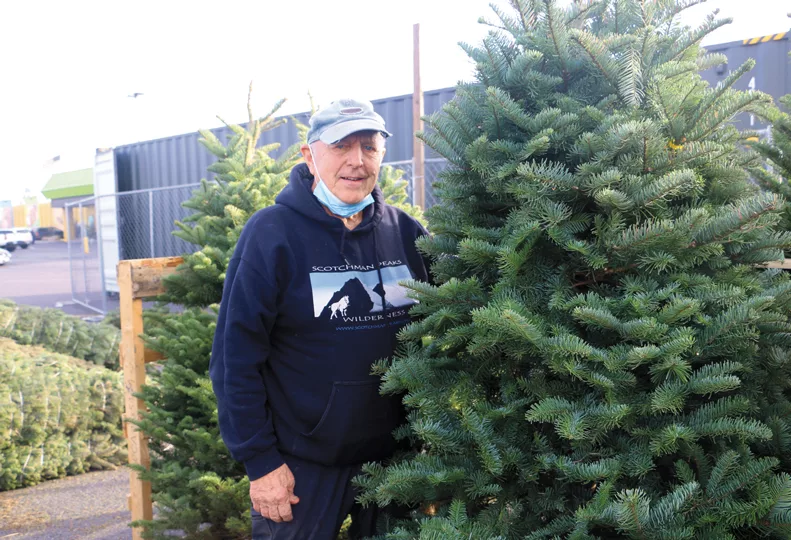Q&A with Storybook Trees owner Emory Clark
~

At age 81, Emory Clark is just about as spry and enthusiastic as he was at age 14.
That’s when he started selling wild, hand-cut Christmas trees to a friend’s uncle. Decades later, he still harvests wild trees, which he sells wholesale. With the profits from wholesale trees, he purchases roughly 300 farmed Christmas trees, which he sells each year at Storybook Trees. Storybook Trees, an assumed name for Clark’s Hi-Country Nursery, is a popup Christmas tree shop in the parking lot of the Yoke’s Fresh Market grocery store in Airway Heights. Clark does everything — from cutting to selling — with some help from a couple of employees.
How did you get your start selling Christmas trees?
Two of us in Clark Fork, Idaho, started going to farmers in the area and cutting wild Christmas trees along the edge of their pastures and along roadways. I borrowed my brother’s old 1939 Plymouth, and we stuck the trees in the trunk and sold them to my friend Billy’s uncle. He was a wholesaler, and he paid us $1.50 a tree. We did really well for kids — 14 years old and we were making probably $100 a day.
Billy and I worked together for years and years, until we were grown. In fact, we were together 30 years or more, and then poor Billy got killed in an auto accident. But I’ve been going ever since by myself. I was a juvenile probation officer at Spokane County Juvenile Court for years, and I’ve done lots of other things. But consistently over the years, I’ve had Christmas tree lots every year. And when I didn’t have a lot, I sold trees wholesale.
Why have you stuck with it for all these years?
It’s invigorating. It’s fun. I still cut wild Christmas trees in the mountains. Most of my trees I cut in northern Idaho and western Montana on U.S. Forest Service permits. If you love the mountains, it’s the ideal business, to be up there where it’s so beautiful.
I’ve had a lot here at Yoke’s in Airway Heights for probably 20 years or so. Before that, I had them here and there all over town. Every year I’ve had at least one, sometimes two retail sales lots. That’s fun, too. If you have a good product and everybody likes what you’ve got, they’re happy. I pay people based on commission for selling the trees. Once they do it, they just love it. Some of them say it’s the most fun they’ve ever had, just being around a bunch of happy people around Christmastime.
I love the physical end of it. It’s like going to the gym all day. I’m up there in the mountains, and at my age, I’m in practically perfect shape because of this work. In spring and fall, I also dig wild transplant stock. I buy that from the Forest Service. That keeps me busy, too, because I dig them all by hand myself, and then I have crew guys put the burlap on the root balls of the trees. That’s another income stream a couple of times a year. I wish it was every day of the year. My wife keeps wanting me to slow down and move to other things I like to do, but I’m hooked on this business and being in the woods and the mountains.
How do you give back to the community?
Starting my 50th year of business, I decided to start donating Christmas trees through some of the charities in town, one for each year I’d been in business. I take most of them to Catholic Charities and then have a number on my lot to donate to people who are struggling. This year I’m talking to Lutheran Community Services. I want them to help find people who are really deserving and are having a tough time.
In past years, I’ve donated only the trees. I’ve learned that many struggling families have no tree stand to put the tree in, or the money to go out and buy one, or lights to fill in the tree. So, the tree isn’t used to its full extent. This year, I’m asking for help. I need 67 tree stands this year, and strings of LED lights. We’re going to decorate them right in our lot and take them with a stand and lights right to people’s homes.
All of us should do whatever we can. I can’t do too much, but I can sure give them some trees.
What happens to the unsold trees?
If you sell down to where you only have 5% of your trees left, if you start with 300, you’ll have only 15 left. It looks like a lot, but it really isn’t.
Believe it or not, farmers that raise goats around the area love to get all the trees they can for their goats. They’ll come and pick them up from the lot when they’re left over, because goats love the foliage on the tree. I usually get rid of mine by making a few phone calls.
What’s the biggest change you’ve seen in the retail Christmas tree industry over the decades?
Going back years and years, they used to all be wild. The biggest change was the large influx of farm-grown trees.
For a while, it was like it might even stop the wild tree industry. For a century, people all over the United States who had no trees growing near them bought wild trees that were mostly from Montana. That business was heavily impacted by farm-grown trees.
Besides that, it fluctuates. You never know if it’s going to be really good. This year, quite frankly, I’m worried. Because of COVID-19, there may be reluctance from people to put trees in. It’s a crapshoot, I don’t know what to expect.
This interview has been edited for length and clarity.
Related Articles
Related Products

_c.webp?t=1763626051)
_web.webp?t=1764835652)

